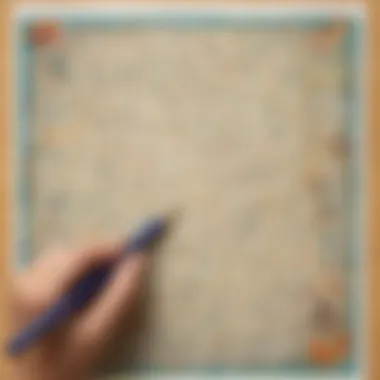Create an Engaging Word Search with Spelling Words


Intro
Creating word searches with spelling words can be an engaging method to reinforce learning. This activity offers children an interactive platform to enhance vocabulary and spelling skills. By transforming learning into a fun puzzle, educators and parents can make lessons stickier and more enjoyable. The process of crafting these puzzles is intuitive but does require some attention to detail to ensure both educational value and enjoyment.
This guide will provide a thorough walkthrough on how to create effective word searches, integrating significant educational principles. Additionally, we will explore ways to incorporate other interactive learning activities and strategies that can be effective for children's cognitive development.
Interactive Learning Games
Incorporating interactive learning games can significantly enrich the educational experience for children. Word searches stand out not only because they challenge children's minds but also because they provide opportunities for critical thinking and problem-solving.
Popular Games
Educational games come in various forms, suited for different learning styles and ages. Here are some notable examples:
- Scrabble: Enhances vocabulary and spelling.
- Pictionary: Encourages creativity and teamwork.
- Quizlet: Uses flashcards for various subjects.
- Kahoot!: Interactive quizzes that can be played in groups.
Description of Top Educational Games
Each of these games melds learning into fun styles, providing unique opportunities to improve cognitive skills and knowledge retention. For instance, Scrabble involves strategy while reinforcing spelling knowledge effectively.
Benefits of Playing Educational Games for Kids' Cognitive Development
Educational games provide several benefits for children:
- Enhance problem-solving skills: Games require strategies that can translate to real-world scenarios.
- Boost social skills: Many games encourage group play, fostering communication.
- Improve focus: Games that engage children sidetrack them from distractions, improving their attention spans.
"Games are crucial as they help children learn without even realizing it." – Educational Expert
Tips and Tricks
Parents and educators can apply practical strategies to boost children's learning using word searches and other educational games. Here are key tips:
- Integrate themes: Blend spelling words with subjects like science or history to deepen learning.
- Set goals: Encourage children to solve puzzles within certain time limits for added excitement.
- Mix difficulty levels: Utilize various word lengths and directions to avoid frustration but still challenge them.
Creative DIY Projects
Another engaging aspect of learning is through creative DIY projects. Hands-on activities not only stimulate creativity but also reinforce concepts learned through puzzles and other games.
Step-by-Step Guides
Creating DIY activities can be a fun way to bridge game playing with hands-on learning. For example:
- Choose a topic (e.g., animals, geography).
- Create spelling words related to the topic.
- Develop a word search or crossword.
Craft Ideas
Using simple household items, you can make learning dynamic and creative:
- Nature collages: Gather leaves and other items, labeling them with their spellings.
- Story stones: Paint stones with words and use them to create sentences.
These projects not only nurture artistic expression but also aid in reinforcing vocabulary retention through playful learning.
Prelude to Word Searches
Word searches are a unique tool in the educational landscape, blending amusement with learning. They offer a multifaceted approach that enhances vocabulary acquisition and reinforces spelling skills. For many students, word searches shift the process of learning from a monotonous task to an engaging activity. This adjustment can be particularly beneficial for children who struggle with traditional learning methods.
Benefits of Word Searches in Learning


The benefits of word searches in an educational context extend beyond mere entertainment. They encourage cognitive development and critical thinking. When children engage with word searches, they develop several essential skills:
- Enhanced Vocabulary: By working on specific spelling words, children expand their word bank.
- Improved Focus: Finding words in a grid requires concentration, which is beneficial in honing attention spans.
- Fine Motor Skills: Physically circling or highlighting words helps in developing dexterity.
- Pattern Recognition: Children learn to identify patterns within letters, aiding in broader reading skills.
Moreover, word searches can introduce compexity by incorporating themes relevant to subjects being taught, which fosters a deeper understanding of the content.
Target Audience for Word Searches
Word searches can be tailored to various audiences. The primary groups include:
- Children: Young learners can benefit immensely. They enjoy the playful nature of puzzles, which keeps their interest high.
- Parents: Parents looking for educational activities often find word searches an adaptable option for helping their children with schoolwork.
- Teachers: Educators use word searches as a practical tool for reinforcing lessons. They can integrate these puzzles into lesson plans to assess comprehension.
- Caregivers: For guardians, these activities can stimulate mental activity in children, fostering an enjoyable learning environment.
Choosing the Right Spelling Words
Choosing the right spelling words is crucial in creating an engaging word search puzzle. Selecting appropriate words enhances educational outcomes and ensures that the activity resonates with children. Words should not only relate to the subject matter but also be familiar to the intended audience. The right words turn a simple puzzle into a useful learning tool, reinforcing vocabulary and spelling skills.
When selecting words, consider their length and complexity. If the goal is to engage younger audiences, words should be simple and straightforward. Conversely, more advanced learners may benefit from longer and less common words. This balance is vital for maintaining interest and ensuring a challenge without leading to frustration.
Another important factor is the relevance of selected words to the learning objective. For instance, if the word search is intended to reinforce thematic vocabulary, the words should directly relate to that theme. This approach not only makes the puzzle more educational but also helps children connect with the material in a meaningful way.
Criteria for Selecting Words
When determining which spelling words to include, several criteria should guide your selection:
- Relevance: Ensure that the words relate to the subject matter or theme targeted.
- Familiarity: Use words that children are already familiar with, as this will enhance their confidence.
- Diversity: Include a mix of nouns, verbs, and adjectives to expand vocabulary understanding.
- Length: Choose a variety of short and long words to maintain engagement.
- Phonetic Patterns: Consider using words with specific phonetic rules to boost phonemic awareness.
These criteria can help create a word search that feels cohesive and aligned with educational goals. By focusing on relevant and familiar words, teachers and parents can create a more inviting learning experience.
Tailoring Words to Age Groups
Tailoring word choices to different age groups is essential for effective learning. Children have varying levels of language proficiency based on their age and education level. Here are some strategies to ensure words are appropriate:
- Younger Children (Ages 5-8): Focus on simple, everyday words. For instance, including names of common animals or objects can make the activity relatable. Words like "cat", "dog", or "tree" resonate well.
- Middle Childhood (Ages 9-12): Introduce more challenging words. You can select words from subjects they are currently studying. Words like "gravity" or "ecosystem" are good examples that can stimulate interest.
- Older Children (Ages 13+): At this stage, complexity should increase further. Utilize advanced vocabulary that aligns with their curriculum. Words like "metamorphosis" or "economics" can deepen their understanding of more sophisticated concepts.
By carefully considering the age group's needs, word searches can become more than a fun activity. They can be powerful learning tools rather than just another puzzle.
Materials Required for Word Search Creation
Materials are fundamental when creating a word search. They determine how the puzzle is made and the ease with which it can be completed. When parents or educators engage in this activity, the right materials can enhance the experience for children. Understanding the various options available helps in tailoring the word search to specific needs and preferences.
Digital Tools for Word Search Creation
Digital tools represent a modern approach to constructing word searches. Several software and online platforms exist that facilitate the creation process. Tools like Discovery Education's Puzzlemaker allow users to input a list of words and automatically generate a puzzle. Others like Word Search Labs offer customizable templates where one can edit titles and themes.
Using digital tools has its advantages. Firstly, they significantly reduce the time needed for creation. A user can design complex grids in a matter of minutes. Secondly, the ability to save and share puzzles digitally ensures that educators can distribute them instantly. Finally, these tools often come with features such as print options and varying difficulty levels, which can be adjusted according to the audience.
However, one must consider that reliance solely on digital methods may limit creativity. Thus, blending digital tools with traditional methods can provide a balanced approach.
Traditional Methods and Materials
Traditional methods for creating word searches require more hands-on effort but can be very rewarding. Basic materials needed include paper, pen or pencil, and possibly graph paper if one aims for a grid layout. When creating a word search traditionally, the act itself becomes an engaging task. Writing the words, organizing the grid, and filling in the blanks manually allows for deeper involvement.
Some benefits of using traditional methods are:
- Enhanced understanding: Manual construction helps educators learn about spatial arrangements and word placement.
- Personal touch: Each puzzle can be customized with drawings or specific themes relevant to the students’ interests.
- Physical interaction: Engaging children with paper and pencil can be helpful in reducing screen time.
Traditional methods might be slower, but they encourage creativity and personalization. For instance, a teacher might choose spelling words that connect with a specific lesson, integrating different subjects into one activity. This way, the word search becomes not just a game but an educational tool.
"The materials you choose can transform a simple word search into an enriching learning experience. The blend of traditional and digital approaches offers versatility, making it accessible to both learners and educators."


Ultimately, whether utilizing digital tools or traditional methods, understanding their respective benefits aids in crafting effective word searches. Combining both can cater to different learning styles, ensuring that all children can benefit from this activity.
Steps to Create a Word Search Puzzle
Creating a word search puzzle is a structured process that requires planning and attention to detail. The goal is to craft an engaging activity that reinforces spelling skills while capturing the interests of children. Each of the steps outlined below is crucial for ensuring that the final puzzle is both educational and enjoyable.
Step One: Designing the Grid
The first step in creating a word search puzzle is designing the grid. A grid serves as the foundation for the puzzle. Typically, it can range from a simple 10x10 layout to larger grids based on the number of words selected. It is beneficial to begin with a clean framework, laying out rows and columns clearly. Making the puzzle visually appealing can enhance engagement. Consider different shapes or boundaries, enticing young learners from the start.
In designing the grid, keep in mind the physical size of the puzzle. It should be appropriate for the age group. Younger children may benefit from larger letters and spaces, reducing frustration. A neatly designed grid offers clarity in word placement, ensuring that the game is both challenging and fun.
Step Two: Arranging the Words
Once the grid is ready, the next step is arranging the words. This stage is critical as it determines how difficult the puzzle will be. Words can be placed in horizontal, vertical, or diagonal configurations, and can even be reversed. Placing words in varied directions increases complexity; however, balance is key. Too many words in difficult arrangements might discourage children from completing the puzzle.
Consider categorizing the words based on themes. For instance, if the words revolve around animals, grouping them together can enhance recognition skills. Additionally, ensure that there is adequate spacing between words to avoid confusion. The idea is to maintain a fine line between making the challenge engaging without creating frustration.
Step Three: Filling Empty Spaces
After arranging the words, the grid will likely have empty spaces. This is where creativity comes into play. Filling these spaces with random letters not only adds to the visual aspect but also enhances the challenge of finding the right words. Aim for letters that do not form recognizable words themselves, as this could mislead players.
When filling the spaces, ensure that you retain consistency in letter size and style. This attention to detail helps keep the focus on the task at hand, thus making it easier for children to find the words without getting distracted by oddities in font or alignment.
Step Four: Finalizing the Design
The final step in the creation process is finalizing the design. This is where you examine the overall puzzle for clarity and aesthetic appeal. Check for balance in word placement and ensure that it is easy to read. Correct any errors in letter placement or alignment that may have occurred during the word-filling stage.
Adding additional elements, such as a title or theme, can further enhance the experience. Consider including instructions on how to approach the puzzle. For younger children, supplementary images or drawings related to the theme could significantly boost interest.
Once the puzzle reaches its final form, take a moment to review its educational value. Does it effectively reinforce spelling words? Is it appropriately challenging for the target audience? Addressing these questions will affirm that the puzzle aligns well with the educational goals you’ve established.
Final Note: Remember to test your word search puzzle yourself before sharing it with children. This will provide insight into its effectiveness and fun factor, ensuring that it achieves its intended outcomes.
Techniques for Enhanced Engagement
Creating a word search puzzle is not simply about listing words on a grid. It is about fostering interest and making the activity relevant and enjoyable. Engagement factors play a crucial role in educational effectiveness. By incorporating specific techniques, educators and parents can enhance children’s experience with word searches. This section will explore two significant methods: incorporating themes and introducing variations in difficulty.
Incorporating Themes
Integrating themes into word searches offers a more immersive learning experience. Themes can resonate with the interests of children, making the game feel more relevant and exciting. Themed word searches can range from seasons, animals, historical events, to popular book characters. For example, a word search based on seasonal themes, like "Autumn", can include words such as "leaves", "pumpkin", and "harvest". This contextual placement of vocabulary taps into children’s existing knowledge and enhances retention.
- Connection to Curriculum: When themes align with educational goals, these puzzles provide a practical way to reinforce topics being studied in the classroom.
- Aesthetic Appeal: Themed word searches can be visually more engaging. Here, creativity in design allows for illustrations or colors that correspond to the theme, drawing attention to the activity.
Moreover, themes encourage a context for discussion. After completing a themed word search, facilitators can initiate conversations about the words' meanings, further solidifying learning.
Introducing Variations in Difficulty
To maintain engagement over time, it’s essential to vary the difficulty of the word searches. This can help cater to different age groups and skill levels, ensuring that each child finds a challenge appropriate to their level.
- Scaled Complexity: A beginner word search might include shorter, simpler words arranged in a straightforward grid. As children’s skills improve, puzzles can feature longer words, include diagonal or backwards placements, or larger grids overall.
- Time Constraints: Adding a timer for completing the word search can add an element of challenge. Children can race against time to find all words, making it both fun and efficient.
- Hints and Clues: Offering additional hints for difficult words can also be beneficial. This strikes a balance between challenge and frustration, keeping learners engaged without overwhelming them.
The goal is to foster a stimulating environment where children feel inspired to explore and learn.
By applying these techniques, word searches can become more than an exercise in finding hidden words. They can be meaningful tools that support learning objectives and encourage active participation, making the overall experience rewarding for both facilitators and children.
Utilizing Word Searches in Educational Settings
Word searches are more than mere puzzles; they serve as an effective educational tool in various settings. By utilizing word searches, educators can reinforce vocabulary, spelling, and cognitive skills in an enjoyable format. This aligns well with contemporary teaching methodologies that prioritize interactive engagement in learning activities.


Incorporating word searches can enhance students’ ability to recognize words and build connections between letters and sounds. This can be particularly beneficial for younger students, providing them with a playful medium to explore language. Moreover, word searches can cater to different learning styles, appealing to visual learners who thrive on pattern recognition and word placement.
Integrating Word Searches into Lesson Plans
Integrating word searches into lesson plans allows educators to create a more varied instructional environment. Here are several key strategies:
- Subject-Specific Themes: Design word searches around specific themes within the curriculum. For example, if students are studying biology, include terms related to plants or animal classification in the puzzle.
- Vocabulary Reinforcement: Create puzzles that include spelling words students struggle with. This can reinforce language usage and enhance retention.
- Cross-Disciplinary Application: Use word searches in subjects beyond language arts. This could involve incorporating terminology related to history, science, or even art, giving students the chance to engage with content in a new manner.
Such integration not only reinforces learning but also helps in keeping students focused and engaged in the lesson. The activity can be timed or used as a warm-up, allowing for a seamless transition into more intensive learning tasks.
Using Word Searches for Assessment
Word searches also function as practical assessment tools. Here are a few approaches:
- Informal Assessment: Teachers can assess students’ familiarity with vocabulary through their ability to locate words within the puzzle. This can provide insights into areas needing additional focus.
- Custom Assessment Tools: Craft specific word searches to evaluate comprehension of recent lessons. The students’ performance can indicate their understanding of key concepts.
- Peer Assessment: Students can create their own word searches for classmates, which not only involves them in teaching but also deepens their own understanding of the material.
Using word searches for assessment can yield immediate feedback for educators while promoting collaboration and creativity among students.
By following such strategies, teachers can not only enhance engagement but also ensure that the educational benefits of word searches are maximized. This method of learning assists in developing not only academic skills but also critical thinking and problem-solving abilities, essential for holistic educational growth.
Troubleshooting Common Issues
Creating a word search with spelling words can be a rewarding experience, but it is not without its pitfalls. Understanding how to troubleshoot common issues ensures that the puzzle is enjoyable and educational. This section aims to address specific challenges that may arise during the creation process. Being aware of these issues allows for smoother puzzle creation and enhances the overall learning experience for children.
Addressing Difficulty Levels
One common issue in word search creation is the varying difficulty levels of puzzles. It is crucial to align the word search complexity with the age group of the intended audience. If the difficulty is too high, children may feel frustrated and disengaged. Conversely, if it is too easy, they may not feel challenged enough to learn from the activity.
To effectively address difficulty levels, consider the following:
- Word Length and Familiarity: Choose words that are appropriate for the age group. Younger children may benefit from shorter and more familiar words, while older children can handle longer or less common terms.
- Grid Size: The size of the grid can also affect difficulty. A smaller grid generally leads to an easier search, while larger grids provide more challenge.
- Placement Variety: Introducing a mix of horizontal, vertical, and diagonal placements can increase the complexity without overwhelming the participant.
Incorporating feedback from children or educators can provide valuable insights for adjusting the difficulty level in real-time. Minor adjustments can make a significant impact, ensuring that the word search remains engaging.
Dealing with Word Placement Challenges
Word placement can pose significant challenges during the creation of a word search. An effectively designed puzzle requires strategic planning. If words are not placed correctly, it can lead to frustration and loss of interest. Here are methods to overcome word placement challenges:
- Visual Mapping: Before filling the grid with words, visualize or sketch the placement. This practice helps in organizing thoughts and avoids cramming words that overlap in confusing ways.
- Testing: After creating the word search, take the time to solve it yourself. This step allows you to identify unexpected complications like excessive overlap or missing words.
- Backup Plan: Sometimes, words simply do not fit as planned. Have a list of alternate words ready, so adjustments can be made without starting over completely.
Ensuring clean and clear word placements can distinguish an engaging word search from a frustrating one. Continuous testing and revisions are key to a successful outcome.
"The enjoyment of a word search often hinges on the careful balance of challenge and accessibility."
In summary, addressing difficulty levels and dealing with word placement can significantly enhance the experience of creating and solving a word search. Remaining flexible and open to changes will lead to a more effective and rewarding learning tool.
Closure and Further Resources
In the realm of enhancing children's education, the creation of engaging word search puzzles using spelling words serves as a valuable tool. The conclusion of this article emphasizes the multi-faceted benefits that come from implementing these puzzles in the learning process. Not only do word searches consolidate vocabulary acquisition, but they also promote cognitive skills such as problem-solving and pattern recognition. Additionally, they offer a sense of achievement when children find the hidden words, reinforcing positive feelings towards learning.
By synthesizing the information discussed previously, we can appreciate the significance of careful selection of words, thoughtful layout design, and ongoing adjustments to difficulty levels. This creates an avenue for educators and parents alike to facilitate enjoyable, educational interactions with children. In a landscape where engagement in learning is paramount, incorporating word searches can stimulate enthusiasm and retention of knowledge.
"Engaging methods such as word searches not only support the learning of spelling words but also foster a love for language and discovery."
Summary of Key Points
- Definition and Purpose: Word searches serve as both an educational tool and a fun activity for children.
- Word Selection: Choosing appropriate spelling words that fit the child's age and learning level is crucial for effective puzzles.
- Puzzle Creation Steps: Understanding the design process—including grid setup, word placement, and filling spaces—ensures a well-crafted product.
- Engagement Techniques: Incorporating themes and varying difficulty keeps children motivated and interested.
- Educational Integration: Word searches can be seamlessly integrated into lesson plans and used for assessments.
- Troubleshooting: Strategies exist for common challenges, such as difficulty levels and word placement issues.
Additional Resources for Educators
For those looking to expand their knowledge and utilize word searches effectively in educational settings, the following resources can be useful:
- Wikipedia - Word Search
- Britannica - Educational Games
- Reddit - Teaching Strategies
- Facebook - Education Groups
These resources provide insights into educational games, strategies for classroom engagement, and further exploration into the best practices for teaching with games. By leveraging these tools, educators can deepen their understanding and enhance the educational experience for children.















